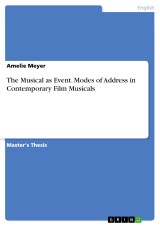Details

The Musical as Event. Modes of Address in Contemporary Film Musicals
1. Auflage
|
CHF 37.00 |
|
| Verlag: | Grin Verlag |
| Format: | |
| Veröffentl.: | 07.04.2020 |
| ISBN/EAN: | 9783346143471 |
| Sprache: | englisch |
| Anzahl Seiten: | 96 |
Dieses eBook erhalten Sie ohne Kopierschutz.
Beschreibungen
Master's Thesis from the year 2014 in the subject American Studies - Miscellaneous, grade: 1,0, University of Göttingen (Philosophische Fakultät), language: English, abstract: At the beginning of the year 2010, movie critic Bob Mondello triumphantly declared “It's going to be another musical decade,” noting the way the previous ten years have prompted a movie musical “resurgence” paving the road for a bright music-filled future.
When looking at the history of musicals over the course of time, this does not always seem to be the case. In spite of the fact that the film musical was an audience favorite during its “Golden Age” era (1927 until the mid-1950s) and celebrating great successes such as 42nd Street (1933) or Singin’ in the Rain (1952), it seems to have deteriorated in quality and reputation. Since recent movie musicals apparently have hit a different, more successful, nerve with audiences, the question is why the genre now sees an uplift in box office numbers. Which elements of recent movie musicals keep audiences glued to the screen? How do they work in tapping into audiences’ emotions, prompting them to participate?
This thesis will be influenced by the methodology of reception study scholar Janet Staiger. Staiger’s 1992 Interpreting Film: Studies in the Historical Reception of American Cinema and Perverse Spectators (2000) reconsider the way audiences make sense of films. With her historical materialist approach taking into account all “traces” of audiences interacting with filmic material, she sets out to find an understanding of why certain films prove to be successful with audiences at certain times (Kemper). She investigates the “modes of address and exhibition,” “establishes the identities and interpretative strategies and tactics brought by spectators to the cinema” and acknowledges cultural groups such as fans who “produce their own conventionalized modes of reception” (23; emphasis in original).
It is the purpose of this thesis, then, to take up the approach of looking at the “contact zone” (Kemper) between films and audiences in order to investigate filmic addresses fostering audience engagement. In doing so, an assortment of recent film musicals that have achieved considerable box office success including Moulin Rouge!, Across the Universe, Hairspray, and Mamma Mia! will be analyzed with regard to particular addresses picked up by audiences, thereby creating the “event” of movie-going. The central question investigated here then asks: Which elements of a particular film are focused on by critical reports and how do these elements shape the movie-going experience, participation, and engagement of viewers?
When looking at the history of musicals over the course of time, this does not always seem to be the case. In spite of the fact that the film musical was an audience favorite during its “Golden Age” era (1927 until the mid-1950s) and celebrating great successes such as 42nd Street (1933) or Singin’ in the Rain (1952), it seems to have deteriorated in quality and reputation. Since recent movie musicals apparently have hit a different, more successful, nerve with audiences, the question is why the genre now sees an uplift in box office numbers. Which elements of recent movie musicals keep audiences glued to the screen? How do they work in tapping into audiences’ emotions, prompting them to participate?
This thesis will be influenced by the methodology of reception study scholar Janet Staiger. Staiger’s 1992 Interpreting Film: Studies in the Historical Reception of American Cinema and Perverse Spectators (2000) reconsider the way audiences make sense of films. With her historical materialist approach taking into account all “traces” of audiences interacting with filmic material, she sets out to find an understanding of why certain films prove to be successful with audiences at certain times (Kemper). She investigates the “modes of address and exhibition,” “establishes the identities and interpretative strategies and tactics brought by spectators to the cinema” and acknowledges cultural groups such as fans who “produce their own conventionalized modes of reception” (23; emphasis in original).
It is the purpose of this thesis, then, to take up the approach of looking at the “contact zone” (Kemper) between films and audiences in order to investigate filmic addresses fostering audience engagement. In doing so, an assortment of recent film musicals that have achieved considerable box office success including Moulin Rouge!, Across the Universe, Hairspray, and Mamma Mia! will be analyzed with regard to particular addresses picked up by audiences, thereby creating the “event” of movie-going. The central question investigated here then asks: Which elements of a particular film are focused on by critical reports and how do these elements shape the movie-going experience, participation, and engagement of viewers?
Diese Produkte könnten Sie auch interessieren:

American Consumer Culture and its Society: From F. Scott Fitzgerald`s 1920s Modernism to Bret Easton Ellis`1980s Blank Fiction

von: Johannes Malkmes

CHF 64.99
















